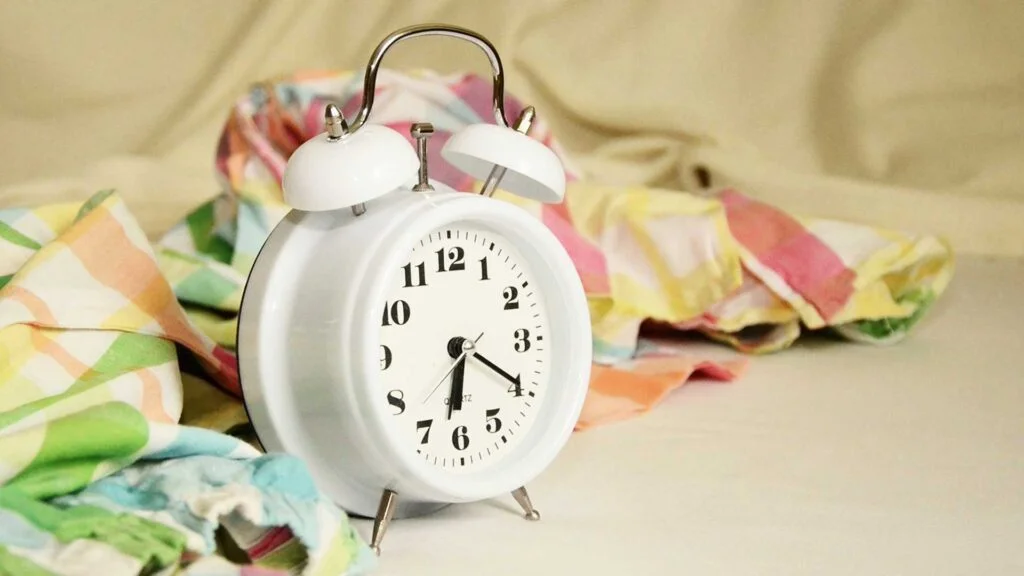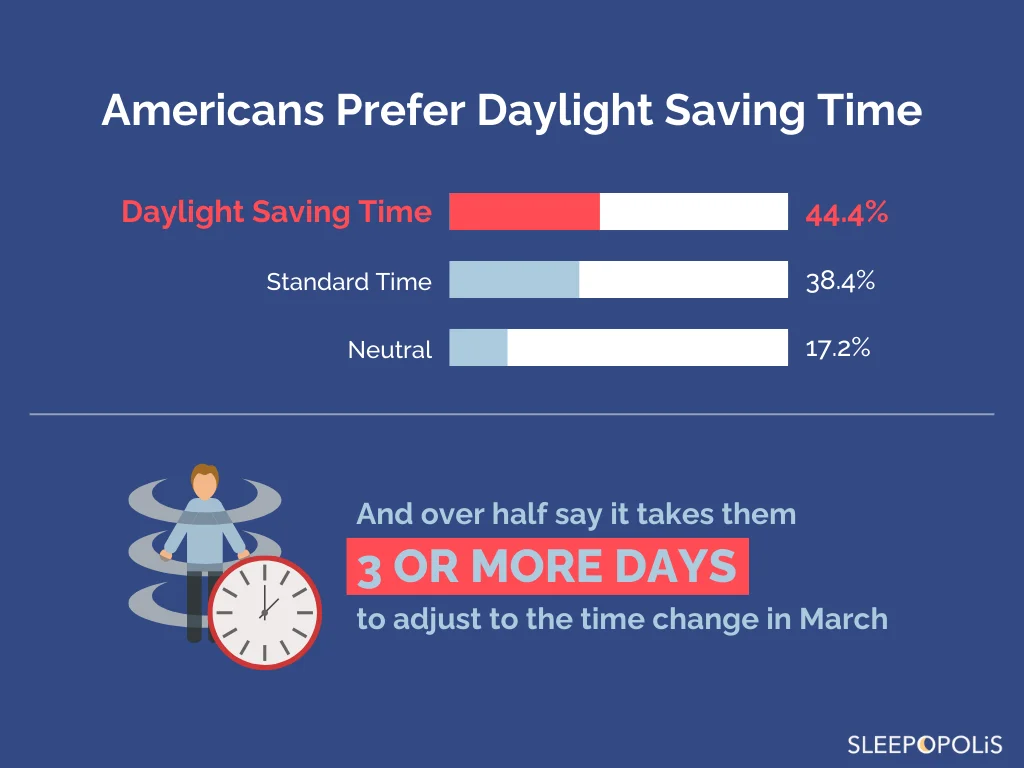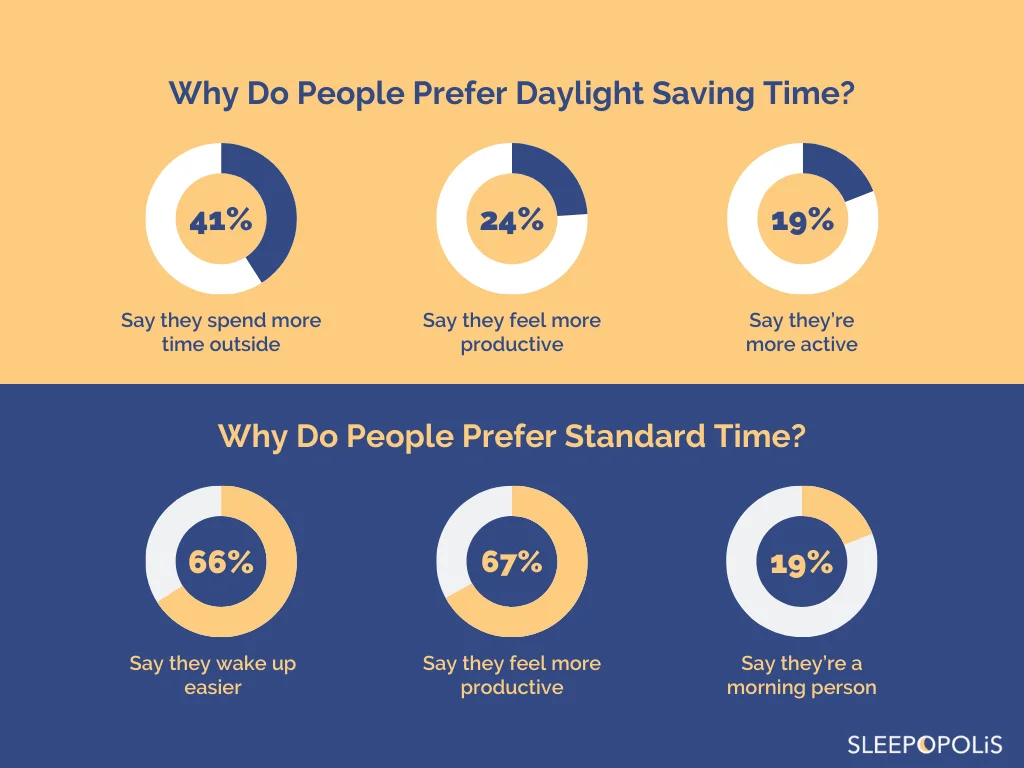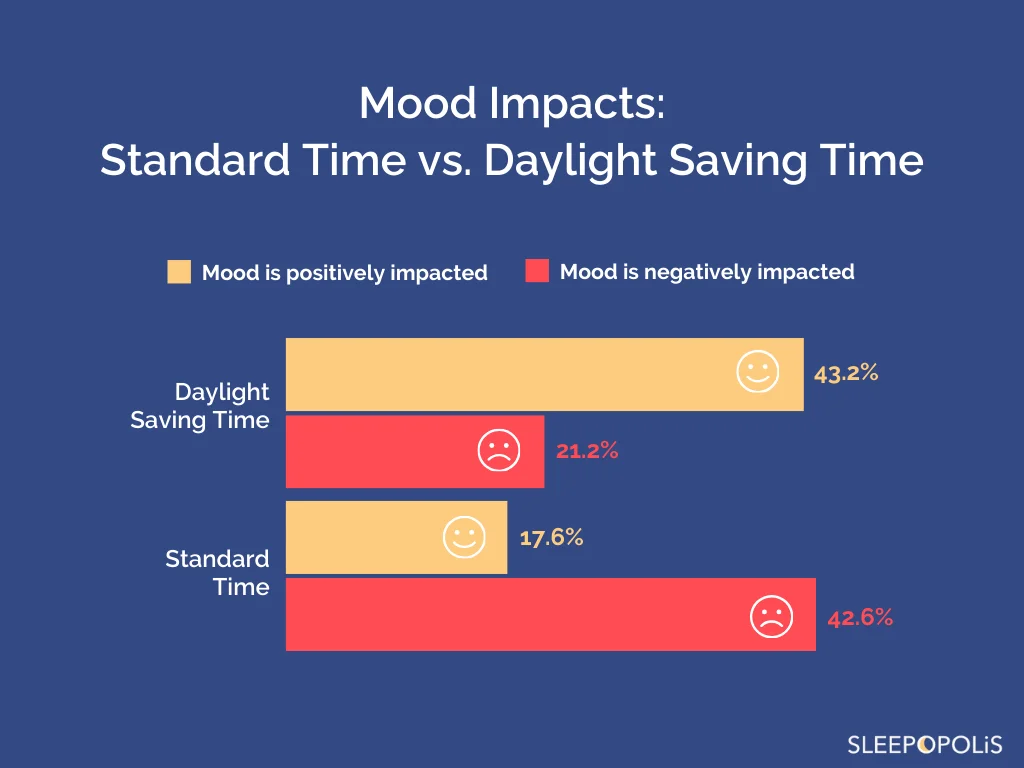
For most Americans, daylight saving time is just a fact of life. Like clockwork, we set our timepieces ahead one hour every March, essentially giving ourselves the gift of time. And every November, we revert to standard time. While many people take it in stride, allowing their devices to manage the change, daylight saving time has been the subject of much debate in recent years. The reasons for doing so have been under fire because adjusting to the time change may cost us more than an hour here or there.
Long Story Short
- Daylight saving time starts on the second Sunday in March each year. It ends (taking us back to standard time) each November.
- Daylight saving time has been under the microscope in recent years as adjusting to daylight saving time seems to have far-reaching implications for our health — not the least of which is its effect on our sleep.
- According to our survey of nearly 1,200 American adults, 44 percent prefer daylight saving time over standard time, but over half say it takes them more than three days to adjust.
- Maintaining a consistent sleep schedule, paying attention to your sleep hygiene, and increasing your exposure to light are great ideas for adjusting to the time change.
What is Daylight Saving Time?
Except for Arizona, Hawaii, and U.S. territories, including Puerto Rico, American Samoa, Guam, and the U.S. Virgin Islands, clocks across America will spring forward by one hour this March. (1)
Daylight saving time typically begins on the second Sunday in March and ends in November when we “fall back” by one hour — or back to standard time. Standard time (known as winter or normal) is the local time in a given region when Daylight Saving Time (DST) is not used.

Why Do We Have Daylight Saving Time?
Penning an essay titled “An Economical Project,” where he extolled the idea of meddling with time twice a year, Benjamin Franklin is often credited with the concept of daylight saving. However, the practice of switching our clocks back and forth should be credited to Englishman William Willett, who, in 1907, published a brochure entitled — you can almost guess it — “The Waste of Daylight.” (2) Within the pamphlet Willet argued for advancing clocks during the warmer months (so people would get out of bed earlier and take full advantage of the daylight) and returning to winter (or standard) time in the fall.
While Willet lobbied for these changes until he died in 1915, it wasn’t until World War I that the United States (and several other countries) adopted the concept of daylight saving time. (2) However, it wasn’t as much fun in the sun — it was about saving energy and conserving resources for the war effort. However, the change only lasted for a spell, as daylight saving time was repealed in 1919 once the war was over. (3)
Fast forward to 1966, when Congress put Daylight Saving Time up for a vote via the Uniform Time Act. This gave each state a choice to adopt DST or opt-out. (4) In the end, the bill passed, and President Lyndon Johnson signed it into law on April 13, 1966. (5)
Beyond giving us more time to enjoy some daylight after work, DST may have a few more benefits. (1)
Energy Saving
If DST works as intended, people will spend more time outdoors. Theoretically, that means they’re turning on fewer lights indoors and relying less on electricity. However, some question if this is the case and point out that the increased use of air conditioning may mitigate any energy-saving effects. (1)
Improved Safety and Fewer Accidents
In a recent review of a decade’s worth of data, researchers from the University of Surrey found serious road accidents in the evening hours were dramatically reduced due in part to daylight saving time — and the additional sunlight in the evenings — somewhere to the tune of 15–20 percent. (6)
Promotes Healthy and Active Lifestyles
Instead of heading home after work, locking our doors, and hunkering down until morning, longer daylight hours may boost participation in outdoor and social activities after work. (1)
It’s been over five decades since DST was put on the books, so it begs the question — how do people feel about it today? According to our survey of nearly 1,200 American adults, 44 percent prefer DST. Why?

- 41 percent say they spend more time outside
- 24 percent say they’re more productive
- 19 percent say they’re more active
Meanwhile, 38 percent prefer Standard Time. Their reasons were as follows:
- 34 percent say they wake up more easily
- 26 percent feel more productive
- 19 percent because they’re a morning person
Impacts of Daylight Saving Time
While daylight saving time may get us off the couch, decrease traffic accidents, and save us a few bucks on our electric bills, the disruption is not without issue, especially regarding our physical and mental health and wellness. According to the American Academy of Sleep Medicine (AASM), standard time — remember, this is when we “fall back” — is more closely aligned with our body’s internal clock, and deviations from that time can lead to adverse health events. (7)
One meta-analysis highlighted an association between the transition into daylight saving time and an increased risk of heart attacks, particularly noting a significant rise after the spring shift. (8) While the research is a bit dated, a position statement from AASM also cites an increased risk of stroke associated with the daylight saving time shift. (7)
Research and reports have associated the transition to daylight saving time with various health-related issues, including: (7)
- Increased hospitalizations (due to irregular heart rhythms)
- Missed medical appointments
- Increased emergency room visits
- Mood disturbances
- Suicide (9)
- An uptick in traffic accidents
And it looks like the impact of the bi-annual time change on mental health is a real issue. According to our survey data:

- 21 percent of respondents say their mood is negatively impacted by the clocks springing forward, while 43 percent say falling back negatively impacts their mood.
- 42 percent say DST positively impacts their mood, while 18 percent say it is positively impacted by the standard time or the “fall back.”
Daylight Saving Time Effects on Sleep
For most people, the most notable aspect (and the one we most complain about) of springing forward for daylight saving time is the fact that we lose one whole hour of sleep. (7) And while most of us regularly give up an hour or three to get to the end of the internet or binge-watch our favorite shows, that additional hour can wreak more havoc on our sleep.
“Changing clocks back an hour can alter your circadian rhythm and may impact your ability to sleep/wake up when you normally would,” says Dr. Shelby Harris, Sleepopolis’ Director of Sleep Health. “Your circadian rhythm is your body’s internal clock that regulates what time you go to sleep and when you wake, so even changing the clock as little as an hour can impact your sleep quality and/or quantity. Ultimately, it may take a few days for your body to adjust to this change in schedule.” (7)
Our survey showed as much, with more than half of respondents saying it takes them over three days to adjust to the clocks springing forward in March.
The science here is easy enough. The transition to DST means darker mornings and more evening light. (7) This combination of factors causes a delay in our sleep-wake cycle, which leaves most of us tired in the morning and more alert in the evening (when we should be winding down to catch our forty winks). Ultimately, the circadian misalignment we experience contributes to sleep loss. (7)
Our survey showed that with an average wake-up time of around 7:10 a.m., many Americans wake up in the dark at the start of DST. Not surprisingly, 72 percent of people say they struggle to wake up when it’s dark out.
So, Is it Better to “Spring Forward” or “Fall Back” When it Comes to Getting Quality Sleep?
In short, it’s not as simple as saying one is better. “Both time changes alter your sleep/wake cycle, which can impact your sleep quality and/or quantity,” says Harris. “In the fall, when you gain an extra hour, you may notice that it’s more difficult to fall asleep, and you wake up earlier in the morning. But it’s more likely to affect kids than teens and adults. In the spring, you lose an hour of sleep, and you might not get as much quality sleep as you need until your body fully adjusts to the earlier bedtime.”
How to Adjust to Daylight Saving Time
Losing an hour here or gaining an hour there may be different from what the sleep doctor ordered, but there are things you can do to help yourself with the changeover. Here are some of our best tips for adjusting to daylight saving time.
Work Up To The Adjustment
Abrupt change is part of the issue with advancing our clocks in the spring and reverting to standard time in the fall. If you’re one of the many who find it hard to get on track, consider adjusting your bedtime in the days leading up to the switch. This means going to bed 15 to 20 minutes earlier each night before Daylight Saving Time officially begins. By the time the clocks switch over on Sunday, you’ll be ahead of the curve.
Optimize Your Sleep Environment
Create an environment conducive to sleep by keeping your bedroom dark, cool, and quiet. If need be, consider using blackout curtains to block out the sunlight that peeks into your room during the extended evenings.
Maintain a Consistent Sleep Schedule
“A consistent sleep/wake time can also help your body better adjust to the time change, so try to sleep and wake up around the same time every day,” says Harris. “You should adjust within 5-7 days.” (8)
Grab the Daylight
Most of us love sunlight, but you may be surprised to learn it can help you sleep better, too. “Try to get as much daylight exposure as you can in the morning and afternoon to help ease the adjustment,” says Harris. “This can help to align your circadian rhythm and help you feel more energized in the afternoon. You can also use light in the evening to help with early sleepiness from the lack of sunlight, but make sure to dim any lights or screens at least an hour before bedtime to help you fall asleep faster.”
Prioritize Sleep Hygiene
When longer daylight hours make it difficult to get some shuteye, it might be a good time to clean up your sleep hygiene. Harris says. “Try to limit caffeine within eight hours of bedtime and limit large meals, alcohol, and strenuous exercise within three hours of bed. It can also help to adjust your meals and activities 15–20 minutes later than you normally would.”
The tips outlined above should help you adjust to the time change, but Harris says if your sleep hasn’t gotten back on track after two weeks, it may be time to speak with a sleep doctor.
Why do we need daylight saving time?
We don’t necessarily need daylight saving time — it started as a law put on the books in 1966. Initially, it was intended to save energy and promote a more healthy lifestyle.
How do I set my clock for daylight saving?
When daylight saving time starts, we advance our clocks by one hour; when it ends, we return to standard time. A good way to remember the time changes during the year is to “spring” forward in March and “fall” back in November.
Most devices hooked up to the internet should adjust independently, but other devices, like ovens and car clocks, may require additional effort to switch over.
The Last Word From Sleepopolis
Like it or not, most of us in the U.S. must deal with these time changes throughout the year.
While it offers several benefits, the transition between standard and daylight saving time can notably affect physical and mental health, particularly sleep patterns. By understanding these effects and implementing proactive strategies, individuals can mitigate the impact of the time change and smoothly adjust to the new schedule.
Sources
- Wei-Haas, M., & McKeever, A. (2023, March 10). Why daylight saving time exists-at least for now. Science. https://www.nationalgeographic.com/science/article/daylight-saving-time
- William Willett: Daylight Saving and British Summertime. Chislehurst Society. (2018, October 25). https://chislehurst-society.org.uk/pages/about/people/william-willett-daylight-saving-and-british-summer-time/
- Daylight Saving Time | Home Front Contributions | Echoes of the Great War: American Experiences of World War I | Exhibitions at the Library of Congress | Library of Congress. Library of Congress, Washington, D.C. 20540 USA.
- Uniform time. U.S. Department of Transportation. (n.d.). https://www.transportation.gov/regulations/time-act
- The Uniform Time Act of 1966. Robert C. Byrd Center for Congressional History and Education. https://www.byrdcenter.org/blog/the-uniform-time-act-of-1966
- Laliotis, I., Moscelli, G., & Monastiriotis, V. (2023). Summertime and the drivin’ is easy? Daylight saving time and vehicle accidents. Health Economics, 1–XXX. https://doi.org/10.1002/hec.4715
- Rishi MA, Ahmed O, Barrantes Perez JH, et al. Daylight saving time: an American Academy of Sleep Medicine position statement. J Clin Sleep Med. 2020;16(10):1781-1784. doi:10.5664/jcsm.8780
- Manfredini R, Fabbian F, Cappadona R, De Giorgi A, Bravi F, Carradori T, Flacco ME, Manzoli L. Daylight Saving Time and Acute Myocardial Infarction: A Meta-Analysis. Journal of Clinical Medicine. 2019; 8(3):404. https://doi.org/10.3390/jcm8030404
- Osborne-Christenson EJ. Saving light, losing lives: How daylight saving time impacts deaths from suicide and substance abuse. Health Econ. 2022;31 Suppl 2:40-68. doi:10.1002/hec.4581
- Harris, Shelby. Personal Interview. February 6, 2024.

























